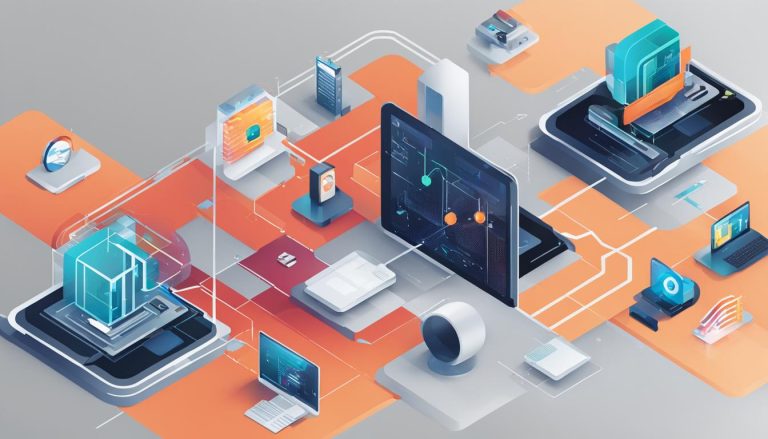Greetings! In this article, I’ll provide a comprehensive overview of IPv6, including its definition and how it works. Are you ready to dive into the fascinating world of internet protocols? Let’s get started!
Before we delve into the details, let’s establish what IPv6 actually is. IPv6, or Internet Protocol version 6, is the successor to the widely used IPv4 addressing infrastructure. Why was IPv6 developed, you ask? Well, the current IPv4 system is running out of addresses due to the immense growth of internet-connected devices. This prompted the need for a more expansive and efficient addressing scheme, hence the birth of IPv6.
So, what makes IPv6 different? Unlike IPv4, which utilizes 32-bit addresses, IPv6 addresses use a whopping 128 bits. This increased address space allows for a virtually limitless number of unique addresses, catering to the ever-expanding internet landscape. To represent these addresses, IPv6 uses hexadecimal notation, making it quite distinct from the familiar dotted decimal notation of IPv4.
Key Takeaways:
- IPv6 is the successor to IPv4 and addresses its limitations.
- IPv6 offers a larger address space with 128-bit addresses.
- IPv6 addresses are written in hexadecimal notation.
- IPv6 enables the connection of an increasing number of devices.
- Adoption rates for IPv6 are on the rise.
Now that we have a basic understanding of IPv6, let’s explore its features, benefits, address format, comparison to IPv4, adoption, and migration strategies in the upcoming sections. Stay tuned!
Features and Benefits of IPv6
IPv6 offers a wide range of features and benefits that make it a superior choice over its predecessor, IPv4. One of the key advantages of IPv6 is its significantly larger address space, with over 340 undecillion possible addresses. This abundance of addresses allows for the seamless connection of an ever-growing number of devices, enabling the expansion of the Internet of Things (IoT). With IPv6, there is no longer the scarcity of addresses that plagued IPv4, ensuring that every device can have its unique identifier.
Another major feature of IPv6 is its streamlined packet processing. IPv6 headers are simpler and more efficient, resulting in faster and more optimized network communication. Additionally, IPv6 supports multicast packet flows, allowing for efficient data transmission to multiple recipients simultaneously. This feature is particularly useful for multimedia streaming, online gaming, and real-time communications.
IPv6 also brings about several benefits in terms of network configuration and security. With IPv6, hosts can generate their own IP addresses, eliminating the need for network address translation (NAT) and simplifying network setup. Furthermore, IPv6 enables the implementation of services such as peer-to-peer (P2P) networks and voice over IP (VoIP). In terms of security, IPv6 includes built-in support for IPsec, a suite of protocols for ensuring secure communication over the internet.
Table: IPv6 Features and Benefits
| Feature | Benefit |
|---|---|
| Large Address Space | Allows for the connection of an ever-increasing number of devices and the expansion of the Internet of Things (IoT). |
| Streamlined Packet Processing | Enables faster and more efficient network communication. |
| Multicast Packet Flows | Facilitates efficient data transmission to multiple recipients simultaneously. |
| Host-Generated IP Addresses | Eliminates the need for network address translation (NAT) and simplifies network setup. |
| P2P Networks and VoIP | Enables the implementation of peer-to-peer networks and voice over IP services. |
| Built-in IPsec Support | Enhances network security and ensures secure communication. |
IPv6 Address Format and Structure
The format and structure of IPv6 addresses play a crucial role in the efficient routing and identification of devices on the internet. Unlike the familiar dotted decimal notation used in IPv4, IPv6 addresses are written using hexadecimal notation and consist of eight groups of 16 bits each separated by colons. This allows for a significantly larger address space of 128 bits, providing trillions upon trillions of unique addresses.
Each IPv6 address comprises two main components: the network component and the node component. The network component, also known as the prefix or subnet, occupies the first 64 bits of the address. It is used for routing purposes and identifies the network to which the device belongs. The remaining 64 bits form the node component, which is derived from the device’s physical or MAC address using the extended unique identifier (EUI-64) format.
| Address Component | Description |
|---|---|
| Network Component | The first 64 bits of the IPv6 address, used for routing and identifying the network. |
| Node Component | The remaining 64 bits, derived from the device’s physical or MAC address, identifying the device. |
In addition to the network and node components, the IPv6 address format includes options for different types of addresses. Global unicast addresses are used to identify devices on the global internet. Unique local addresses are reserved for use within private networks, similar to private IP addresses in IPv4. Link local addresses are automatically assigned to devices on a local network segment and are primarily used for communication within the local network.
Understanding the format and structure of IPv6 addresses is essential for network administrators and engineers when configuring and managing IPv6 networks. It enables them to properly assign addresses, implement routing protocols, and ensure efficient communication between devices across the internet.
IPv6 and IPv4 Comparison
When comparing IPv6 and IPv4, the most significant difference lies in the address space. IPv4 addresses are limited to 32 bits, resulting in approximately 4.3 billion possible addresses. On the other hand, IPv6 addresses utilize 128 bits, providing a staggering number of possible addresses – over 340 undecillion. This vast address space is crucial in accommodating the growing number of Internet-connected devices, especially with the rise of the Internet of Things (IoT).
Another difference between IPv6 and IPv4 is the address format. IPv4 addresses are written in dotted decimal notation, such as 192.168.0.1, while IPv6 addresses use hexadecimal notation, consisting of eight groups of four hexadecimal digits separated by colons. For example, a typical IPv6 address would look like 2001:0db8:85a3:0000:0000:8a2e:0370:7334. This change in format allows for a much larger address space and simplifies the addressing scheme.
Additionally, IPv6 has specific protocol enhancements compared to IPv4. IPv6 requires IP security (IPSec) implementation, which provides enhanced security features, including authentication and encryption. In contrast, IPSec is optional in IPv4. Moreover, IPv6 incorporates automatic network configuration, eliminating the need for manual configuration or Dynamic Host Configuration Protocol (DHCP) in IPv4.
| Comparison | IPv6 | IPv4 |
|---|---|---|
| Address Space | 128 bits (over 340 undecillion addresses) | 32 bits (approximately 4.3 billion addresses) |
| Address Format | Hexadecimal notation | Dotted decimal notation |
| Protocol Enhancements | Requires IPSec | IPSec is optional |
| Network Configuration | Automatic network configuration | Manual configuration or DHCP |
In summary, IPv6 presents a significant advancement over IPv4, primarily in terms of address space, address format, and protocol enhancements. The adoption of IPv6 is essential for future-proofing network infrastructures and accommodating the ever-growing number of connected devices. While IPv4 is still widely used, the transition to IPv6 is gradually gaining momentum, driven by the necessity to support the expanding Internet ecosystem.
IPv6 Adoption and Migration
IPv6 adoption rates continue to increase at a rapid pace, reflecting the growing demand for addresses and the need to future-proof network infrastructures. While small businesses, home networks, and home offices may not yet feel the full impact of this transition, it is essential to understand the migration strategies and adoption practices associated with IPv6.
All modern computers and mobile phones now support both IPv4 and IPv6, with many devices being assigned both types of addresses. This dual-stack IP implementation allows for a smooth transition to IPv6 without disrupting existing IPv4 connectivity. However, migrating to IPv6 requires technical expertise, effort, and time.
Organizations can choose from various transition mechanisms, such as tunneling and translation, to facilitate the adoption of IPv6. Dual-stack implementation is a common approach that enables devices to communicate using both IPv4 and IPv6 protocols simultaneously. By gradually transitioning services and infrastructure, businesses can minimize disruptions and ensure a seamless migration to IPv6.
| Migration Strategies | Advantages |
|---|---|
| Dual-Stack Implementation |
|
| Tunneling |
|
| Translation |
|
It is important for organizations to assess their network infrastructure, evaluate the compatibility of their devices and applications with IPv6, and develop a comprehensive migration plan. By embracing IPv6 adoption, businesses can unlock the benefits of a larger address space, streamlined packet processing, and enhanced security.
Conclusion
In conclusion, IPv6 is the next generation of Internet Protocol addresses, designed to overcome the limitations of IPv4. With its significantly larger address space and streamlined packet processing, IPv6 offers numerous benefits and opens up possibilities for new services and improved security.
Although IPv6 adoption has been slow, the increasing demand for addresses and the growth of the Internet of Things (IoT) will drive the migration to IPv6. As more devices connect to the internet, the need for IPv6 will become more evident.
Organizations should take the time to understand the features, benefits, address format, and migration strategies associated with IPv6 to ensure smooth transitions and future-proof their network infrastructures. It is essential to stay ahead of the curve and prepare for the inevitable shift to IPv6.
As the internet continues to evolve, embracing IPv6 is crucial for long-term sustainability and connectivity. By embracing the opportunities IPv6 presents, organizations can ensure their networks remain secure, scalable, and ready to support the ever-expanding digital landscape.
FAQ
What is IPv6?
IPv6 is the next generation of Internet Protocol addresses, designed to overcome the limitations of IPv4. It offers a larger address space, streamlined packet processing, and support for new services and improved security.
What are the features and benefits of IPv6?
IPv6 provides a significantly larger address space, simplifies packet processing, supports multicast packet flows, enables the implementation of services like peer-to-peer networks and VoIP, and improves security.
How is an IPv6 address formatted?
An IPv6 address consists of 128 bits, arranged in eight groups of 16 bits each. Each group is represented by four hexadecimal digits separated by colons.
What is the difference between IPv6 and IPv4?
The main difference between IPv6 and IPv4 is the increase in address space. IPv6 addresses are 128 bits, while IPv4 addresses are 32 bits. IPv6 also uses hexadecimal addressing notation, requires IPSec, and supports automatic network configuration.
How is IPv6 adoption progressing?
IPv6 adoption rates are increasing rapidly, with IPv6 traffic crossing the 10% threshold in February 2016. However, it will likely take many years for IPv6 to become an issue for small businesses, home networks, and home offices.
What is the conclusion regarding IPv6?
IPv6 is the future of Internet Protocol addresses and is essential for addressing the increasing demand for addresses and the growth of IoT. Organizations need to understand IPv6 features, benefits, address format, and migration strategies to future-proof their network infrastructures.
Hi, I’m Mark, the author of Clever IT Solutions: Mastering Technology for Success. I am passionate about empowering individuals to navigate the ever-changing world of information technology. With years of experience in the industry, I have honed my skills and knowledge to share with you. At Clever IT Solutions, we are dedicated to teaching you how to tackle any IT challenge, helping you stay ahead in today’s digital world. From troubleshooting common issues to mastering complex technologies, I am here to guide you every step of the way. Join me on this journey as we unlock the secrets to IT success.


